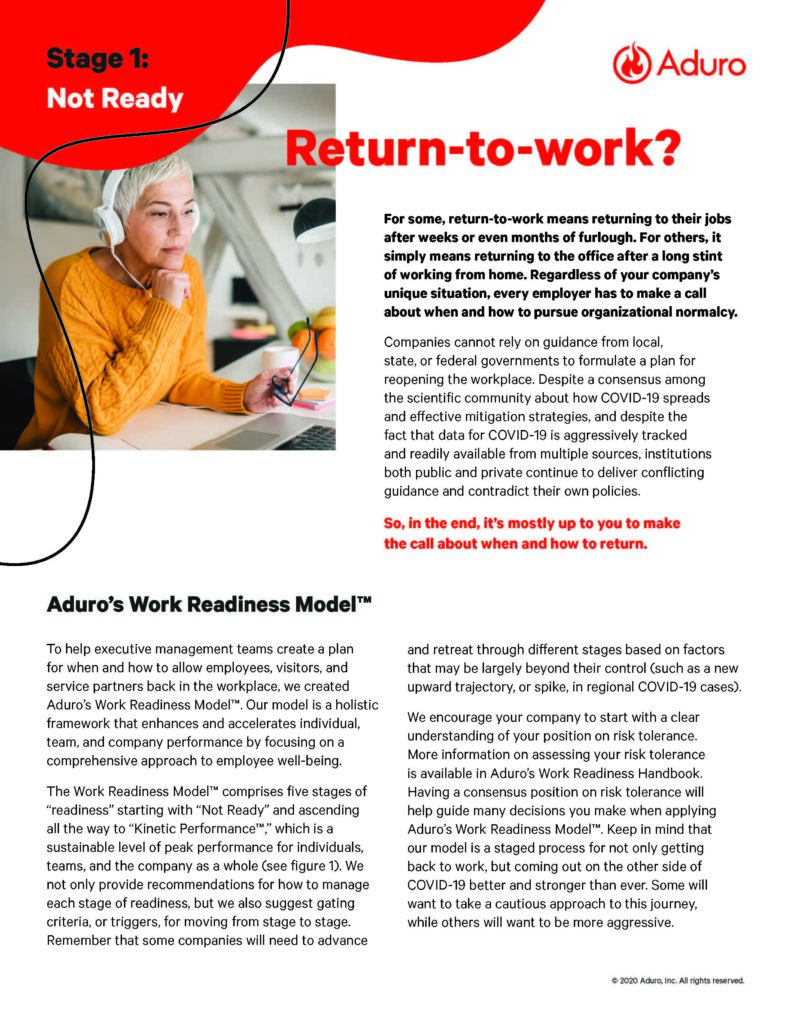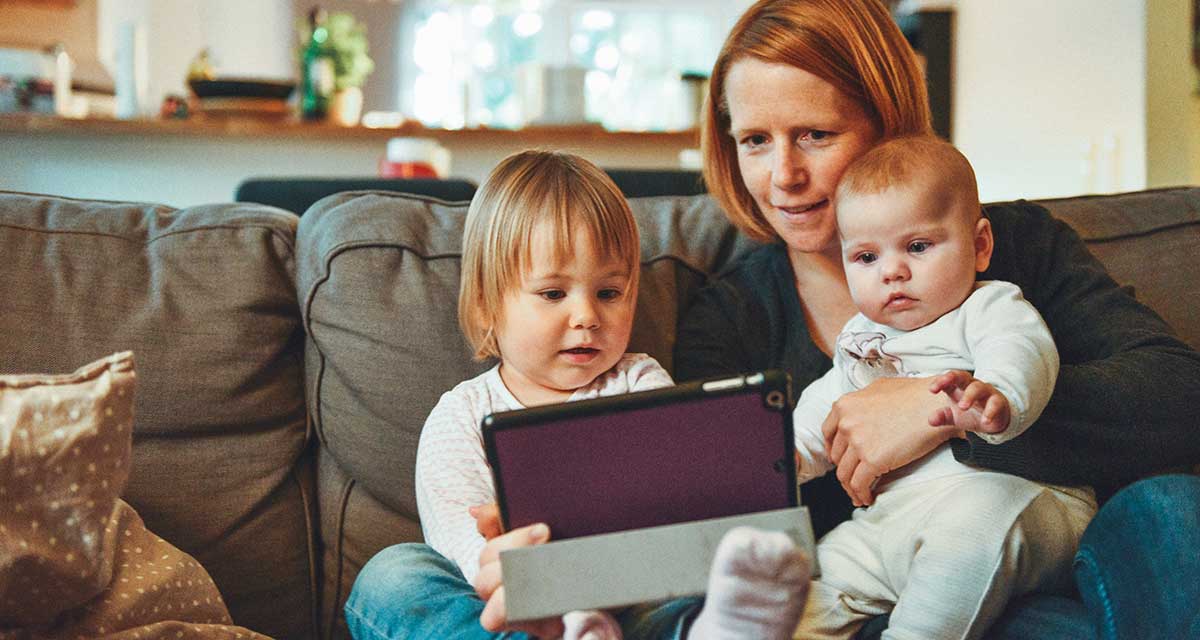Return to Work?
For some, return to work means returning to their jobs after weeks or even months of furlough. For others, it simply means returning to the office after a long stint of working from home. Regardless of your company’s unique situation, every employer has to make a call about when and how to pursue organizational normalcy.
Companies cannot rely on guidance from local, state, or federal governments to formulate a plan for reopening the workplace. Despite a consensus among the scientific community about how COVID-19 spreads and effective mitigation strategies, and despite the fact that data for COVID-19 is aggressively tracked and readily available from multiple sources, institutions both public and private continue to deliver conflicting guidance and contradict their own policies.
So, in the end, it’s mostly up to you to make the call about when and how to return.
Aduro’s Work Readiness Model™
To help executive management teams create a plan for when and how to allow employees, visitors, and service partners back in the workplace, we created Aduro’s Work Readiness Model. Our model is a holistic framework that enhances and accelerates individual, team, and company performance by focusing on a comprehensive approach to employee well-being.
The Work Readiness Model comprises five stages of “readiness” starting with “Not Ready” and ascending all the way to “Kinetic Performance™,” which is a sustainable level of peak performance for individuals, teams, and the company as a whole (see figure 1). We not only provide recommendations for how to manage each stage of readiness, but we also suggest gating criteria, or triggers, for moving from stage to stage. Remember that some companies will need to advance and retreat through different stages based on factors that may be largely beyond their control (such as a new upward trajectory, or spike, in regional COVID-19 cases).

We encourage your company to start with a clear understanding of your position on risk tolerance. More information on assessing your risk tolerance is available in Aduro’s Interactive Work Readiness Handbook. Having a consensus position on risk tolerance will help guide many decisions you make when applying Aduro’s Work Readiness Model. Keep in mind that our model is a staged process for not only getting back to work, but coming out on the other side of COVID-19 better and stronger than ever. Some will want to take a cautious approach to this journey, while others will want to be more aggressive.
In this article, we will be discussing the first stage of our work readiness model: Not Ready. Download a pdf here.
Stage One: Not Ready
Many companies (and their employees, visitors and service partners) are simply not ready to return to the workplace. Perhaps their physical locations are in regions where the trajectory of new cases is still on the rise. Or perhaps they have not experienced significant declines in business performance after transitioning to a distributed work model and choose to remain “closed” out of an “abundance of caution.” For most employees, this means working from home.
Companies should not force employees to return to the workplace until they have met their pre-defined triggers for moving to Stage 2. Aggressive or ultra-aggressive companies may have already encouraged people to return to the workplace based on the lifting of restrictions in their state. These companies have already met their trigger for moving to Stage 2. But moderate, conservative and ultra-conservative companies are likely waiting for a longer sustained downward trajectory of new cases in their impacted regions. Regardless, companies who are “Not Ready” to allow people back in the workplace should be focused on maintaining productivity and maximizing individual well-being while waiting or working from home.
Companies who are “Not Ready” to allow people back in the workplace should be focused on maintaining productivity and maximizing individual well-being while waiting or working from home.
Employee Needs
Working from home during the era of COVID-19 creates major stressors. For many, balancing work with other obligations like childcare and housework leaves little time for self-care. On top of obvious stressors, many families have lost the help of friends, family members, and service workers due to social distancing regulations. And all of this is, of course, compounded by the increased friction associated with formerly simpler errands like grocery shopping or meal preparation.
Solutions
To navigate this difficult transition to a new working style balanced with the multiple stressors created by working from home, companies must be prepared to offer their employees an array of solutions. A bundle of solutions for Stage One must necessarily include:
- Coaches – Even if working (or waiting) from home is not new for some, the current situation is unprecedented for all. And balancing work with increased domestic demands is not intuitive for most, so we could all probably use a little help. Expert coaching, rooted in science, can help individuals identify their needs and create plans for succeeding in this new environment.
- Resources – Additional resources such as interactive content and peer-to-peer connections can help reinforce positive attitudes, behaviors and beliefs while helping stave off feelings of isolation and even depression. Systems that provide alerts, nudges and personalized action are powerful tools for maintaining gains in well-being.
- Well-being Tracking – Tools that encourage employees to “check-in” on a daily basis, providing information about their physical health and mood can help employers provide support to people when it is needed most, while also identifying potential health risks to the broader population of employees as the company prepares to reopen the workplace.
- Effective Communication – Finally, communication is of paramount importance in a distributed work environment. Without the luxury of multiple in-person meetings and casual hallway conversations on a daily basis, important information is not as efficiently disseminated in a virtual work environment. Check in daily with your employees providing them with the important information they need to create their own return to work plans, because each person in your company will have unique concerns and needs. Remember, the best plans and policies are no better than the worst if they are not consistently communicated.

Are We There Yet?
Let’s be honest. It’s the answer that everyone wants. Are we there yet? And if not, how much longer? The unfortunate reality is that no one can plan this journey for you. Much like a long road trip, you’ll need to pick your path, decide how fast you’ll drive, how many breaks you’ll take and when to pull over or even turn around. Start your return to work journey by agreeing as an executive management team how much you are willing to risk between organizational normalcy and employee safety. Then once you understand your risk tolerance, plot your course and stick to it.
We created Aduro’s Interactive Work Readiness Handbook to offer practical guidance on what should be considered when deciding when and how to reopen your offices. We hope you find it to be one valuable source among many to help guide your decisions during one of the most challenging times in world history.


